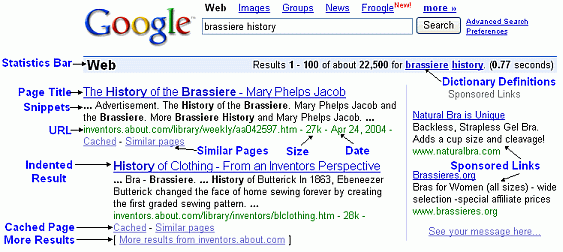The results page is filled with information and links, most of which relate to your query.

- Google Logo: Click on the Google logo to go to Google’s home page.
-
Statistics Bar: Describes your search, includes the number of results on the current results page and an estimate of the total number of results, as well as the time your search took. For the sake of efficiency, Google estimates the number of results; it would take considerably longer to compute the exact number. This estimate is unreliable.
Every underlined term in the statistics bar is linked to its dictionary definition. Queries that are linked to just one definition are followed by a definition link.
- Tips: Sometimes Google displays a tip in a box just below the statistics bar.



-
Search Results: Ordered by relevance to your query, with the result that Google considers the most relevant listed first. Consequently you are likely to find what you’re seeking quickly by looking at the results in the order in which they appear. Google assesses relevance by considering over a hundred factors, including how many other pages link to the page, the positions of the search terms within the page, and the proximity of the search terms to one another.
Below are descriptions of some search-result components. These components appear in fonts of different colors on the result page to make it easier to distinguish them from one another.
- Page Title: (blue) The web page’s title, if the page has one, or its URL if the page has no title or if Google has not indexed all of the page’s content. Click on the page title (e.g., The History of the Brassiere - Mary Phelps Jacob) to display the corresponding page.
-
Snippets: (black) Each search result usually includes one or more short excerpts of the text that matches your query with your search terms in boldface type. Each distinct excerpt or snippet is separated by an ellipsis (…). These snippets, which appear in a black font, may provide you with
- The information you are seeking
- What you might find on the linked page
- Ideas of terms to use in your subsequent searches
When Google hasn’t crawled a page, it doesn’t include a snippet. A page might not be crawled because its publisher requested no crawling, or because the page was written in such a way that it was too difficult to crawl.
- URL of Result: (green) Web address of the search result. In the screen shot, the URL of the first result is
inventors.about.com/library/weekly/aa042597.htm. -
Size: (green) The size of the text portion of the web page. It is omitted for sites not yet indexed. In the screen shot, “5k” means that the text portion of the web page is 5 kilobytes. One kilobyte is 1,024 (210) bytes. One byte typically holds one character. In general, the average size of a word is six characters. So each 1k of text is about 170 words. A page containing 5K characters thus is about 850 words long.
Large web pages are far less likely to be relevant to your query than smaller pages. For the sake of efficiency, Google searches only the first 101 kilobytes (approximately 17,000 words) of a web page and the first 120 kilobytes of a pdf file. Assuming 15 words per line and 50 lines per page, Google searches the first 22 pages of a web page and the first 26 pages of a pdf file. If a page is larger, Google will list the page as being 101 kilobytes or 120 kilobytes for a pdf file. This means that Google’s results won’t reference any part of a web page beyond its first 101 kilobytes or any part of a pdf file beyond the first 120 kilobytes.
- Date: (green) Sometimes the date Google crawled a page appears just after the size of the page. The date tells you the freshness of Google’s copy of the page. Dates are included for pages that have recently had a fresh crawl.
-
Indented Result: When Google finds multiple results from the same website, it lists the most relevant result first with the second most relevant page from that same site indented below it. In the screen shot, the indented result and the one above it are both from the site
inventors.about.com.Limiting the number of results from a given site to two ensures that pages from one site will not dominate your search results and that Google provides pages from a variety of sites.
-
More Results: When there are more than two results from the same site, access the remaining results from the “More results from…” link.
When Google returns more than one page of results, you can view subsequent pages by clicking either a page number or one of the “o”s in the whimsical “Gooooogle” that appears below the last search result on the page.

If you find yourself scrolling through pages of results, consider increasing the number of results Google displays on each results page by changing your global preferences.
In practice, however, if pages of interest to you aren’t within the first 10 results, consider refining your query instead of sifting through pages of irrelevant results. To simplify such refinements, Google includes a search box at the bottom of the page you can use to enter your refined query.
- Sponsored Links: Your results may include some clearly identified sponsored links (advertisements) relevant to your search. If any of your search terms appear in the ads, Google displays them in boldface type.
- Spelling Corrections, Dictionary Definition, Cached, Similar Pages, News, Product Information, Translation, Book results: Your results may include these links, which are described in the next few chapters.
Here’s another screen shot of the results page in case the one at the top of this page scrolled off your screen.

